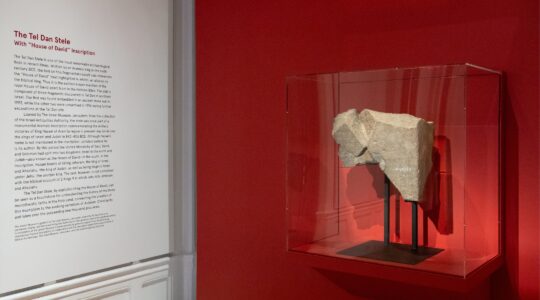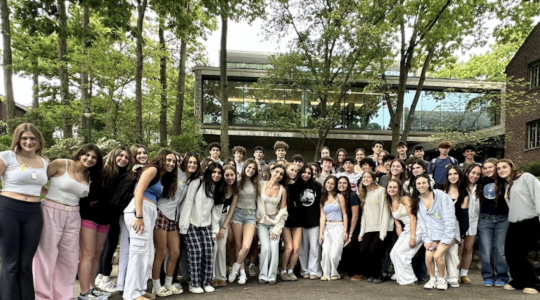Poznan, Poland — The eyes of Poland’s Jewish history are upon me when I come here for Passover.
Three years ago I led the seders, as a volunteer, in the Lublin yeshiva that that been renovated and returned to the Jewish community, in the eastern part of the country. It was established about 100 years ago by Rabbi Meir Shapiro, the scholar better known as founder of the Daf Yomi Talmud study project. As I moved around the meeting hall where the seders took place, a framed portrait of Rabbi Shapiro hung on the front wall, his eyes, I imagined, watching me.
This year I went west, to Poznan, a factory and university city of 600,000 that was called Posen during centuries of Prussian and German rule. Posen was the home of Rabbi Akiva Eger, a 19th-century giant in the Jewish world who served as chief rabbi. His picture graces a wall of the small room on the second floor of the Jewish Community building in the center of the city where I led the seders last week.
Across from the rabbi’s likeness are a collage of contemporary prominent Polish Jews, and a row of artworks, cutout drawings of an open Torah scroll and prayer books with clippings from old Yiddish newspapers in place of the traditional Hebrew words — but I felt Rabbi Eger’s presence in the room.
Both places, both experiences, evoked the same feeling. While the Jewish community of Poland today, two decades after communist rule ended, more than six decades after the Holocaust, is but a faint shadow of the Polish Jewry of centuries ago, when it was the heart of the Pale of Settlement and home to thriving Jewish life, it also is not the Jewish community of the communist era, when open practice of Judaism was illegal and most Jews feared to openly proclaim their Jewishness.
Jewish life in Poland is experiencing a revival, a phenomenon I have witnessed and documented during my visits here — as a journalist and as a seder leader — since 1993.
In some locations, the Jewish renaissance is more advanced. Poznan’s is in the early stages, still taking initial steps to rebuild its Jewish life.
Each time I return from Poland inspired.
Each time I go there, I hear the same inevitable questions. Is there
Jewish life there? Is Poland still an anti-Semitic country?
Each time I give the same, respective, answers: yes and no
In Poznan, Poland’s fifth-largest city, my previous impressions were reaffirmed.
Poznan, which has had a known Jewish community for at least 700 years and was the site of the country’s largest Jewish population in the 1500s, was the home to a thousand-plus Jews before World War II, most of whom died in the Shoah. A few hundred came back after Liberation but soon left for the West. There was no organized Jewish life here until Alicja Kobus, a 50ish dynamo with a network of connections in the media and Church and political circles reconstituted a five-member communiity11 years ago. The Jewish Community has slowly grown to about 50, as people with “Jewish roots” discover their Jewish identity or feel comfortable asserting it.
Support the New York Jewish Week
Our nonprofit newsroom depends on readers like you. Make a donation now to support independent Jewish journalism in New York.
Most members of the community attended the seders I led last week in the Jewish community building, a modest three-story brick edifice that had served as a regional archival warehouse since communist times; the building returned to Jewish hands a few years ago with Kobus’ help.
The city’s century-old synagogue — converted into a municipal swimming pool under Nazi occupation — was also restored to Jewish ownership in the last decade, but the Jewish Community lacks the funds to turn it back into a functioning house of worship.
Besides, it’s much too big for the handful of Jews who attend the bi-weekly Shabbat services in the Jewish Community building.
The Jews who attended my seders, and Shabbat services followed by a kosher meal, were accompanied by their non-Jewish spouses and children, a frequent occurrence in formerly communist Eastern Europe and the former Soviet Union. It’s impossible to give an accurate Jewish census count, because no one knows who is Jewish according to Jewish law or who even counts oneself as a Jew — with rampant intermarriage, many people who consider themselves Jewish probably aren’t, and many people who identify as Polish (i.e., Catholic) may actually be Jewish.
So everyone is welcome at services or seders or other communal activities, an open-armed policy practiced across the country with the blessing of Chief Rabbi Michael Schudrich, who is careful to limit certain activities — like Jewish marriage, or counting worshippers for a minyan — to people whose Jewishness is beyond question.
At the events I ran, the participants included an evangelical pastor and two Catholic priests (all of whom conducted their own first-night seders for their own Christian communities), the son of a Righteous Gentile who had saved a young Jewish girl from the Final Solution, and a score of students, mostly young women, from the Hebrew Language Studies program at Poznan’s Adam Mickiewicz University, reportedly the largest-such Hebrew program in the country.
And Poznan Jewry turned out, some dressed in suits and dresses, some in blue jeans.
For the Jews, mostly middle-aged and senior citizens — only one family with two elementary school-age children showed up — it was a chance to socialize with other Jews and learn a little about Jewish traditions.
(My seders, it turned out, weren’t the only ones in town. A nascent Conservative group sponsored its own; a young Chabad representative from New York came at the request of an Israeli businessman to lead one for a dozen people; and a middle-aged women came to the Jewish Community to get a few boxes of matzah for the seders she was to offer in her home.)
For the non-Jews, the seders were a chance to express their solidarity, something I see t every time I’m in Poland on Pesach.
Despite Poland’s reputation as a breeding ground for anti-Semitism, a reputation earned over centuries of enmity and pogroms, philo-Semitism is more common here today, booth Jews and non-Jews declare.
Unlike most countries in West Europe, there are no police standing guard outside the Jewish Community building. There is no graffiti on its outside walls, or at nearby Rabbi Eger Square. At the shul-turned-pool a block from the community’s building, marked by a historical plaque, “anti-Fascism” words are spray-painted, but no swastikas or anti-Jewish scrawlings.
Support the New York Jewish Week
Our nonprofit newsroom depends on readers like you. Make a donation now to support independent Jewish journalism in New York.
The annual Jewish Cultural Festival in Krakow may be the most visible sign of Polish interest in things Jewish, but similar evidence is present, more quietly, here. The Cymes (pronounced tzimmes) Jewish-style restaurant, like nostalgic eateries in many Polish cities, offers such unkosher, meat-and-dairy fare as kreplachs and blintzes, matzah and “Yankiel’s Soup.” The annual Days of Judaism, a series of educational and cultural events that attract thousands of Poles, are a creation of Archbishop Stanislaw Gadecki, who a few years ago had a stained-glass window that depicted a ritual murder scene removed from a Poznan church.
And there’s the Hebrew Language Studies at the city’s largest university.
A few score of students — among them only a few Jews; most are from Catholic families — enroll in the curriculum of grammar and conversational skills and related Jewish topics. I visited a classroom one morning, spoke with the students, and found that their Hebrew was, in many cases, to my chagrin, better than mine.
Why are they studying Hebrew?
They were at a loss to say. Not for a career, because Hebrew fluency doesn’t lead to employment in Poland. Not because of Jewish boyfriends, because there are few Jews to meet here.
“We’re just interested,” one student offered.
Why are the Hebrew classes 90 percent female?
“Because we’re more ambitious” than the guys, one young lady explained.
Members of the classes came to my seders both nights; total attendance at the second seder (about 35 people) was about half of the first night’s, because most of the Jewish community, some traveling from 60 miles away or more, found it too difficult to come twice.
Many people who came said they are the only Jews in their towns; they took home boxes of matzah, making some effort to observe the holiday.
None of them knew how to run their own seder. For the younger generation, opportunities for Jewish education outside of the larger Yiddishkeit centers like Warsaw or Lodz are still sparse.
Few knew more Hebrew than shalom or amen.
Support the New York Jewish Week
Our nonprofit newsroom depends on readers like you. Make a donation now to support independent Jewish journalism in New York.
At my seders, the non-Jewish university students knew more Hebrew than the Polish Jews did. Few of the Jews understood the significance of the holiday’s reading and rituals, but all listened respectfully as I led the seers as part-classroom, part-theater, distributing toy frogs and other yom tov items donated by J. Levine Judaic and Lisa and Rabbi Leonard Levy of Forest Hills, friends of mine.
As the people filed out of the seders, they thanked me for coming to their community.
Some wished me a Chag Sameach, Hebrew for “happy holiday.”
In each case, it was a non-Jew making the greeting. n
E-mail: steve@jewishweek.org
The New York Jewish Week brings you the stories behind the headlines, keeping you connected to Jewish life in New York. Help sustain the reporting you trust by donating today.




